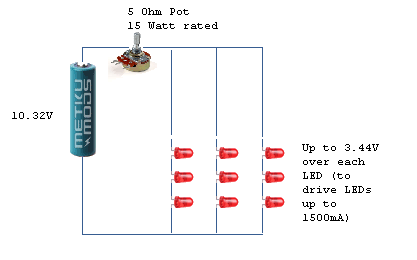Hey CPFers. I've got a bunch of Luxeon Rebels on order and I have plans for them. Not a flashlight, but a fixed light run on DC from the wall.
What I want to do, essentially, is to create a bloody lot of light. And I want it to be dimmable (continuously not discretely).
I plan on driving about 10 rebels (for starters) up to 1500mA each. I don't think any off the shelf drivers are going to cut it because of the current draw. I'm certainly no electrical engineer, but i've drawn up a circuit that i think *might* work. My power supply is variable voltage and regulated, so I can set it to whatever I want. Voltage spikes shouldn't be too significant, it's a good power supply.
Here's what i have (I based my numbers on evan9162's rebel performance data):

I'm not sure if this is going to work - especially the pot as a dimmer. Ideally I want to have a fair bit of control over brightness at the high end, so I don't want it to be too touchy for making adjustments.
I'd be really appreciative if any of you genius modders can give me a hand!
What I want to do, essentially, is to create a bloody lot of light. And I want it to be dimmable (continuously not discretely).
I plan on driving about 10 rebels (for starters) up to 1500mA each. I don't think any off the shelf drivers are going to cut it because of the current draw. I'm certainly no electrical engineer, but i've drawn up a circuit that i think *might* work. My power supply is variable voltage and regulated, so I can set it to whatever I want. Voltage spikes shouldn't be too significant, it's a good power supply.
Here's what i have (I based my numbers on evan9162's rebel performance data):

I'm not sure if this is going to work - especially the pot as a dimmer. Ideally I want to have a fair bit of control over brightness at the high end, so I don't want it to be too touchy for making adjustments.
I'd be really appreciative if any of you genius modders can give me a hand!
Last edited:

